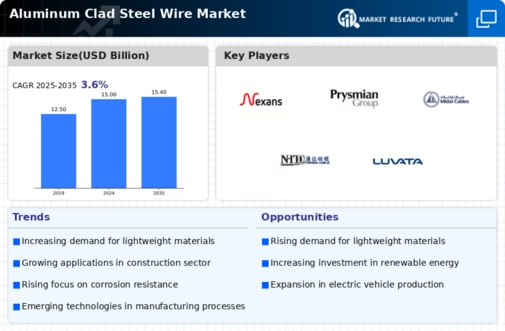Market Analysis
In-depth Analysis of Aluminum Clad Steel Wire Market Industry Landscape
The market dynamics of aluminum clad steel wire are shaped by a combination of factors that influence both supply and demand within the industry. Aluminum clad steel wire is a composite material consisting of a steel core encased in a layer of aluminum, offering a combination of strength, conductivity, and corrosion resistance. The dynamics of this market are driven by factors such as technological advancements, industry trends, regulatory requirements, and economic conditions.
Technological advancements play a crucial role in shaping the aluminum clad steel wire market. Continuous innovation in manufacturing processes, alloy compositions, and coating technologies has led to the development of aluminum clad steel wires with enhanced performance characteristics. These advancements enable manufacturers to produce wires with improved conductivity, mechanical strength, and durability, meeting the demanding requirements of various applications, including overhead power transmission, telecommunications, and automotive wiring harnesses.
Industry trends also influence the dynamics of the aluminum clad steel wire market. Factors such as urbanization, infrastructure development, and renewable energy integration drive demand for high-quality conductive materials, including aluminum clad steel wire. The increasing adoption of overhead power transmission lines, especially in emerging economies, creates opportunities for the use of aluminum clad steel wire in electrical grid infrastructure projects. Moreover, the growing demand for lightweight and corrosion-resistant materials in automotive and aerospace applications further boosts the demand for aluminum clad steel wire.
Regulatory requirements and standards also play a significant role in shaping the aluminum clad steel wire market. Wires used in electrical and telecommunications applications must comply with industry-specific regulations and standards related to conductivity, mechanical strength, and safety. For example, aluminum clad steel wires used in overhead power transmission lines must meet international standards for electrical conductivity, mechanical properties, and corrosion resistance to ensure reliable performance over the long term. Additionally, regulatory requirements related to environmental protection, worker safety, and product quality influence manufacturing processes and product specifications within the aluminum clad steel wire industry.
Economic conditions and market trends impact both supply and demand dynamics in the aluminum clad steel wire market. Factors such as industrial output, construction activity, and infrastructure investments affect the demand for aluminum clad steel wire in various end-use sectors. Economic downturns may lead to reduced construction activity and lower demand for aluminum clad steel wire, while periods of economic growth and recovery stimulate demand for conductive materials, including aluminum clad steel wire. Moreover, fluctuations in raw material prices, energy costs, and currency exchange rates can impact the cost of production and supply chain dynamics within the aluminum clad steel wire industry.


 Source: Secondary Research, Primary Research, Market Research Future Database and Analyst Review
Source: Secondary Research, Primary Research, Market Research Future Database and Analyst Review





Leave a Comment